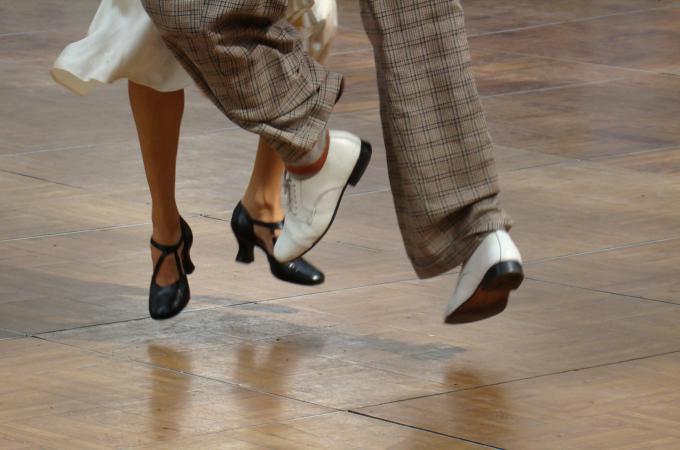Ballroom dance 'swings' through Youville
A circle of older adults forms around a young man dressed in black. It is a Tuesday afternoon at Youville House Assisted Living. The residents wait with expectant smiles as the young man cues up big band music. In the most natural manner, he approaches "Mary," a 100 year old resident who uses a walker. "Would you like to dance?" he asks. As the music plays, the young man and older woman glide across the floor together.
The man is J. Michael Winward, a dance instructor who offers special ballroom dance classes for older adults like those at Youville Place. With Winward leading, Mary is able to follow his steps and get into the rhythm. She is smiling, but is also focused, as are the delighted spectators in the room.
Twice a month at Youville, residents like Mary are transported in time, often surprising themselves by how easily they can relearn familiar dance steps. It helps that Winward is a natural at engaging them. A professional dancer who has won numerous competitions, he looks forward to dancing with Youville residents just as much as they enjoy dancing with a talented young partner.
"I am inspired by the idea that people of all ages can have the chance to dance," Winward says on his website. "Ballroom dancing has the power to bridge generational and cultural divides."
For many who came of age during the Depression and World War II, ballroom dancing was an important part of social life and popular culture. Fred Astaire, Rita Hayworth, Ginger Rogers and Gene Kelly made timeless films in which fancy dancing was the main attraction. Though these films may seem dated to modern viewers, the allure of ballroom dancing -- both as spectator and participant -- lives on. Reality shows like "Dancing with the Stars" have exploded in popularity, and younger people today are discovering that dance offers a unique, structured opportunity to socialize, bond with partners and learn a new skill.
Regardless of one's experience or agility, dance has wide-ranging health benefits. It is one of the few cardiovascular workouts that enables us to connect physically with music in a structured social setting. Regular dancing strengthens bones and tones muscles throughout the body, leading to increased overall strength as well as improved balance and coordination. In older age, improved coordination can be invaluable in preventing falls and osteoporosis.
Dance can also reduce the risk of heart disease, the number one killer of Americans today. Just 30 minutes of moderate dancing can burn 150 calories. Long-term benefits include reduced blood pressure and improved circulation.
If it's been a while since you last "cut a rug," here is a brief, by no means complete, overview of some popular ballroom dance styles.
Cha Cha
The Cha Cha came to American ballrooms in the 1950s. Danced to 4/4 music, the steps are manageable because they tend to be short. The Cha Cha emerged from the music of Cuban composer Enrique Jorrin and the Orquesta American. The signature "cha-cha-cha" move came about as dancers improvised a triple step while dancing to this music.
Swing
Arguably the most energetic of ballroom styles, swing dance features versatility, complex steps and bold improvisation. There are many types of swing, most of which come from African American communities. The most well-known is the Lindy Hop. Like the dance itself, Lindy Hop's christening was itself an improvisation. When asked to name the dance, "Shorty" George Snowden riffed on one of the most noteworthy current events of the time: Charles Lindbergh's transatlantic flight. "Lindy Hop" was born.
The Foxtrot
You've surely danced the Foxtrot, one of the most straightforward of ballroom dances. It is danced to 4/4 time. According to an instructional video on Jazz Age dances, the steps are "just walking." Dance partners hold each other close and coordinate long, sweeping strides across the dance floor.
The popularity of ballroom dance has ebbed and flowed since its initial swell of popularity in the 1930s and 40s. In a 1992 New York Times article, a dance instructor from Princeton, Neil Clover, offered the following theory: "Whenever we have had a war or hard times, ballroom dancing has been popular." Clover's words ring true. In the midst of conflict or political upheaval, ballroom dancing can reaffirm a sense of collective civility and creative energy.
Youville offers Winward's "Steps in Time" program for older adults, twice a month in Cambridge and Lexington. The program is free and open to the public. To learn more about the Cambridge program, contact Yanira Motto, Director of Marketing of Youville House at 617-491-1234. For the Lexington program, contact Susan Snow, Director of Marketing at Youville Place at 781-861-3535.
- Adam Johnson writes for Youville Assisted Living Residences, member of Covenant Health Systems, a Catholic, multi-institutional health and elder care organization serving New England.



















